The Battle of Bay Trail-D: GIGABYTE J1900N-D3V and ASUS J1900I-C Reviewed
by Ian Cutress on October 17, 2014 10:00 AM ESTCPU Benchmarks
Readers of our motherboard review section will have noted the trend in modern motherboards to implement a form of MultiCore Enhancement / Acceleration / Turbo (read our report here) on their motherboards. This does several things, including better benchmark results at stock settings (not entirely needed if overclocking is an end-user goal) at the expense of heat and temperature. It also gives in essence an automatic overclock which may be against what the user wants. Our testing methodology is ‘out-of-the-box’, with the latest public BIOS installed and XMP enabled, and thus subject to the whims of this feature. It is ultimately up to the motherboard manufacturer to take this risk – and manufacturers taking risks in the setup is something they do on every product (think C-state settings, USB priority, DPC Latency / monitoring priority, memory subtimings at JEDEC). Processor speed change is part of that risk, and ultimately if no overclocking is planned, some motherboards will affect how fast that shiny new processor goes and can be an important factor in the system build.
Neither the GIGABYTE J1900N-D3V nor ASUS J1900I-C had any form of MultiCore Turbo.
Point Calculations – 3D Movement Algorithm Test: link
3DPM is a self-penned benchmark, taking basic 3D movement algorithms used in Brownian Motion simulations and testing them for speed. High floating point performance, MHz and IPC wins in the single thread version, whereas the multithread version has to handle the threads and loves more cores.

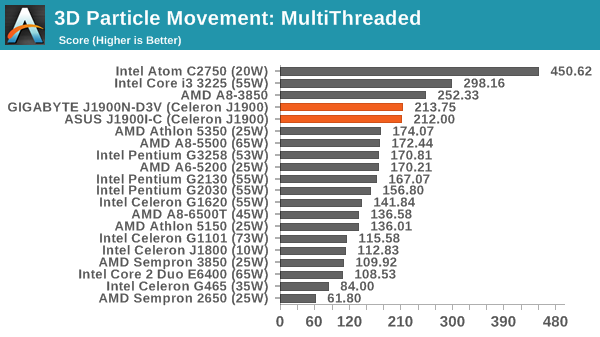
Compression – WinRAR 5.0.1: link
Our WinRAR test from 2013 is updated to the latest version of WinRAR at the start of 2014. We compress a set of 2867 files across 320 folders totaling 1.52 GB in size – 95% of these files are small typical website files, and the rest (90% of the size) are small 30 second 720p videos.
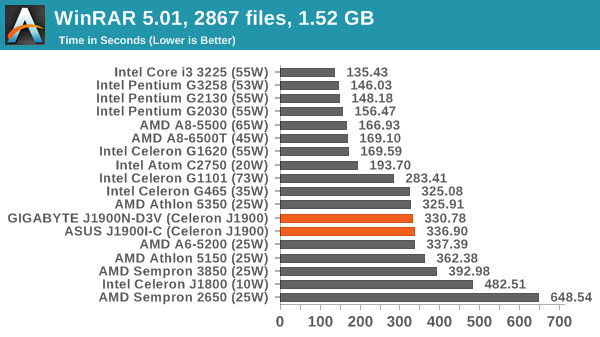
Image Manipulation – FastStone Image Viewer 4.9: link
Similarly to WinRAR, the FastStone test us updated for 2014 to the latest version. FastStone is the program I use to perform quick or bulk actions on images, such as resizing, adjusting for color and cropping. In our test we take a series of 170 images in various sizes and formats and convert them all into 640x480 .gif files, maintaining the aspect ratio. FastStone does not use multithreading for this test, and thus single threaded performance is often the winner.

Video Conversion – Handbrake v0.9.9: link
Handbrake is a media conversion tool that was initially designed to help DVD ISOs and Video CDs into more common video formats. The principle today is still the same, primarily as an output for H.264 + AAC/MP3 audio within an MKV container. In our test we use the same videos as in the Xilisoft test, and results are given in frames per second.
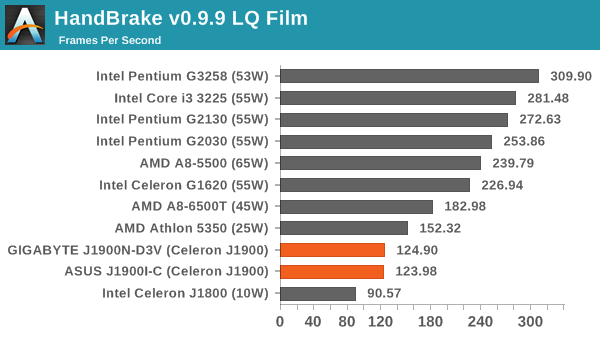
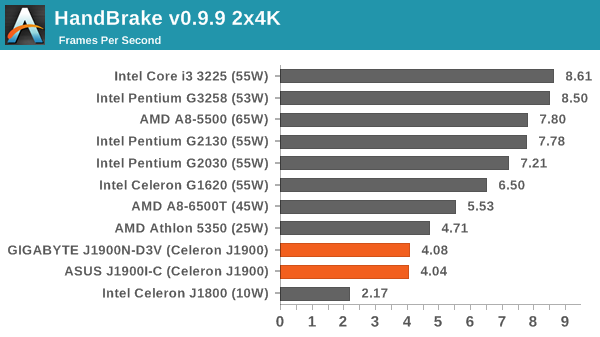
Rendering – PovRay 3.7: link
The Persistence of Vision RayTracer, or PovRay, is a freeware package for as the name suggests, ray tracing. It is a pure renderer, rather than modeling software, but the latest beta version contains a handy benchmark for stressing all processing threads on a platform. We have been using this test in motherboard reviews to test memory stability at various CPU speeds to good effect – if it passes the test, the IMC in the CPU is stable for a given CPU speed. As a CPU test, it runs for approximately 2-3 minutes on high end platforms.

Synthetic – 7-Zip 9.2: link
As an open source compression tool, 7-Zip is a popular tool for making sets of files easier to handle and transfer. The software offers up its own benchmark, to which we report the result.
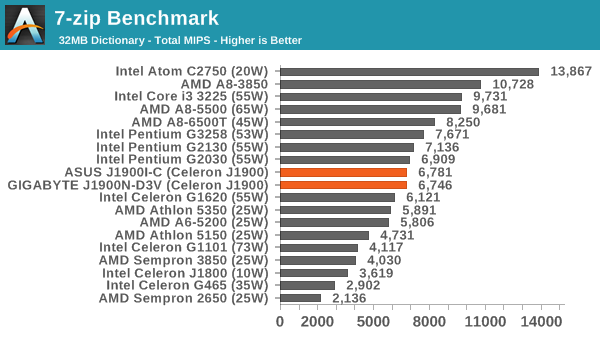
Emulation - Dolphin Benchmark: link
Many emulators are often bound by single thread CPU performance, and general reports tended to suggest that Haswell provided a significant boost to emulator performance. This benchmark runs a Wii program that raytraces a complex 3D scene inside the Dolphin Wii emulator. Performance on this benchmark is a good proxy of the speed of Dolphin CPU emulation, which is an intensive single core task using most aspects of a CPU. Results are given in minutes, where the Wii itself scores 17.53 minutes.
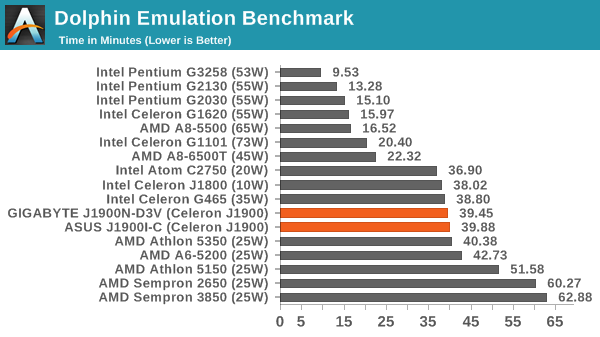
Web Benchmarks on the Celeron J1900
On the lower end processors, general usability is a big factor of experience, especially as we move into the HTML5 era of web browsing. For our web benchmarks, we take four well known tests with Chrome 35 as a consistent browser.
Sunspider 1.0.2
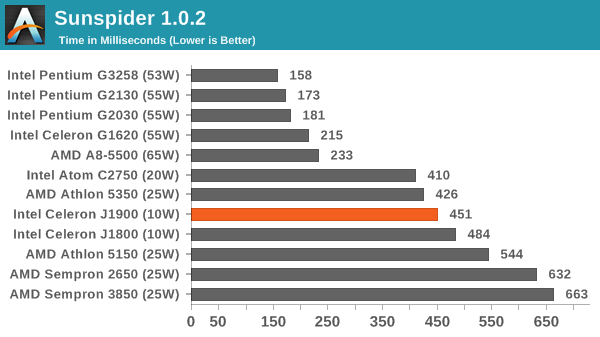
Mozilla Kraken 1.1
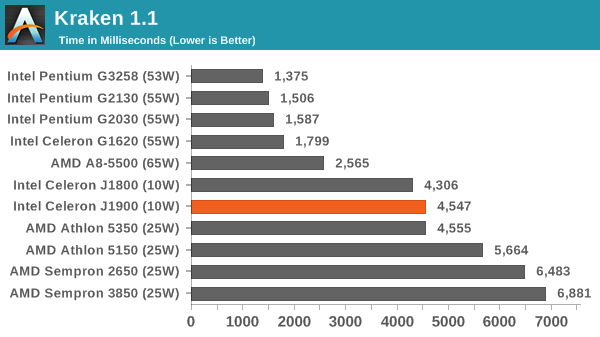
WebXPRT
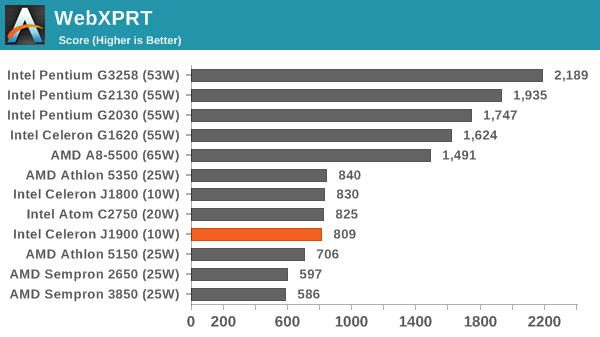
Google Octane v2
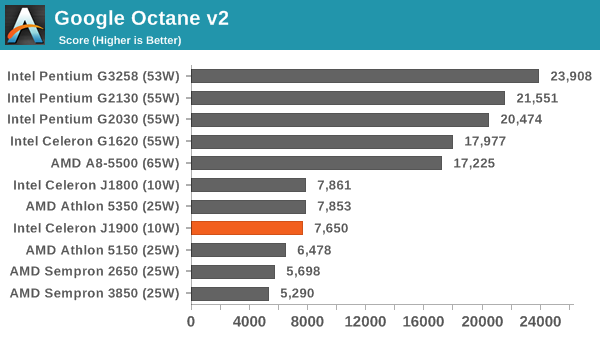










60 Comments
View All Comments
Antronman - Friday, October 17, 2014 - link
I'd much rather be using a Kabini for some mainstream browsing and multimedia.speculatrix - Friday, October 17, 2014 - link
the first UEFI firmware on the Gigabyte motherboard was just awful, the followup F2 was slightly better, but to make it useable you need the F3 version. Updating can be a problem, I started a discussion about it here:http://www.silentpcreview.com/forums/viewtopic.php...
there was a big discussion about baytrail motherboards on the silentpcreview forums, here:
http://www.silentpcreview.com/forums/viewtopic.php...
rstuart - Saturday, October 18, 2014 - link
"Load Delta Power Consumption" is just jargon - and you don't define it. Googling it return just one page of hits. If they are any indication, it total draw from the wall.But even that figure is meaningless unless you tell us what conditions the test was done under. Eg, was the test setup identical for all systems tested, not just the motherboards in question. What power supply was used? What does load was the system put under?
Also, a comparison of the system at idle versus under load would be interesting. Most of the time my systems are idle.
Bonesdad - Saturday, October 18, 2014 - link
White titled on a white background...valkyrie743 - Sunday, October 19, 2014 - link
the ASUS J1900I-C looks like nice for a simple XBMC box.Mvoigt - Sunday, October 19, 2014 - link
Just slap an Zotac geforce 610 PCI 1gb ddr3 in the pci slot and you got and decent machine for sligthly older games.... :) even never ones at low res....evident - Sunday, October 19, 2014 - link
I would have loved to see J2900 numbers in this article as well to represent the top end of these bay trails. I still don't care what anyone says, I still don't feel this is a viable platform for granny's daily web surfing and farmville activities, let alone a HTPC. you just cant justify miserable performance when you can step up to a sandy bridge celeron for way better performance.if you look at real world pricing for J1900 based machines, the only winners are the pc box manufacturers charging $200-300 for this garbage. you can easily pick up a haswell pentium or last generation ivy bridge pentium for that price if you wait for a clearance.
abufrejoval - Tuesday, October 21, 2014 - link
I'd love to see those, too. Even more I'd like to be able to actually purchase J2900 hardware, but I have yet to see any.dealcorn - Monday, October 20, 2014 - link
Several posters have suggested that Kabini may be more attractive than Silvermont. In the real world where companies report revenues quarterly, Baytrail-D and Baytrail-M took significant market share from AMD during the second quarter of 2014. The trend accelerated as Atom claimed increased market share during the third quarter and I believe Dr. Su projects this share loss trend will continue in the fourth quarter. The reasons this occurred are not discussed in the Article but are sort of obvious if you look at real word pricing and real word consumer preferences.Today, Newegg will sell you a AMD’s Kabini 5350 for $65 and a BIOSTAR AM1MHP motherboard with Gb Ethernet for $32 making the 5350 a $97 platform. Alternately, you could buy a ASRock Q1900M with a single Gb Ethernet connection for $70. The real world 5350 platform costs $27 (38%) more. I would argue that ASRock is a preferred brand name over Biostar and perceived brand quality does matter at the low end. Obviously, the 5350 has better graphics for gaming but the J1900 supports 1080p video or better in all major codecs. Because the J1900 is significantly cheaper and has fully adequate graphics for everyone but gamers, sales of the 5350 are limited to cheap dedicated gamers and the 5350 dominates the cheap dedicated gamers segment. Problem is, gamers tend not to be that cheap. For a few dollars more than $97 you can step up to a super gimped Intel big core solution with discrete graphics card and far greater game potential than the 5350 solution. In the real world, it does not help to dominate a market niche with trivial sales volume and the quarterly earning releases of AMD and Intel powerfully make this point.
As a side note, the J1900 motherboards tested in the Article feature dual NIC's and that is an expensive feature in this price class. By way of contrast, Newegg sells no AM1 motherboards with dual NIC's. Because J1900 is very efficient, some folks leave them powered on 24/7 so they can act as a passively cooled firewall/router download station. Finally, Intel does not use contra-revenue with either Baytrail-D or Baytrail-M, These are full margin products. Anyone who asserts otherwise just got hit kinda hard with the stupid stick.
silverblue - Monday, October 20, 2014 - link
I can buy a 5350 for about £40 and a Biostar AM1ML board for £20. An MSI J1900I costs a little under £60, so you can get into both for about the same price. I suppose it depends on features in the end.As it is, AMD should cut at least £5 off the RRP.